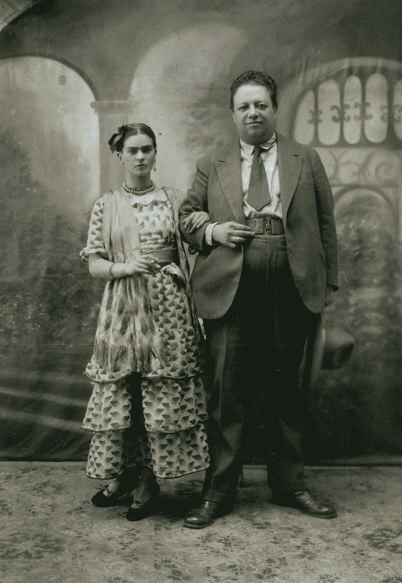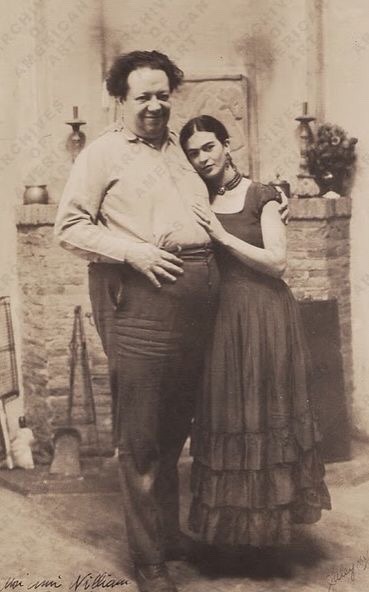Frida Kahlo was born on this day in 1907. Happy birthday Frida! Feliz cumpleaños!
 Frida Kahlo, Self-Portrait Dedicated to Leon Trotsky, 1937
Frida Kahlo, Self-Portrait Dedicated to Leon Trotsky, 1937
In 1938 French Surrealist poet André Breton visited Mexico and upon seeing the paintings of the young artist Frida Kahlo he classified them as works of surrealism which is something she herself denied by saying: “I never paint dreams or nightmares. I paint my own reality.” And indeed, by looking at her paintings and following the events in her life, the parallel is unmistakable. Frida used art as a diary; she used brush and paint instead of a pen and jotted down her feelings, her anguish, her memories, her sense of identity in a similar way that Anais Nin did in her diaries, and Emily Dickinson and Sylvia Plath did in their poems. Looking at Frida’s paintings inevitably draws us into her inner world because the two are inseparable; the viewer yearns to know more about her life and the meaning behind the symbols and motifs she painted. I see her paintings as poetic scenes, verses in vibrant colours, and although they may seem surreal, they are always sincere and woven with depths of her feelings.
 Frida Kahlo With Classic Magenta Rebozo, Nickolas Muray, 1939
Frida Kahlo With Classic Magenta Rebozo, Nickolas Muray, 1939
“I paint self-portraits because I am so often alone, because I am the person I know best.”
Two things that shaped the life and art of Frida Kahlo were her love for a fellow painter Diego Rivera and “the accident”. Love and pain; two sensations so intermingled that the first one can’t possibly live without the other. In her own words: “There have been two great accidents in my life. One was the trolley, and the other was Diego. Diego was by far the worst.” Pain and love followed her like shadows. When she was six years old, she contracted polio and that left her with one leg shorter than the other; she would later hide this defect by wearing man’s clothes or long traditional Mexican gowns. The illness helped to create a strong bond with her father Guillermo who was also of poor health. Although her relationship with her mother was somewhat strained and distanced, Frida loved her father and described him as being tender and understanding. Guillermo was a photographer and not only did he take pictures of his daughter and talked to her about philosophy, nature and literature, but he also encouraged her to practise sport as a way of regaining her health and he inspired her artistic explorations. Little Frida filled notebooks with sketches but never considered art as a profession until “the accident” occurred: on 17 September 1925 she was riding a bus home from school with her boyfriend and the bus collided with a streetcar. A few people died and Frida suffered nearly fatal injuries; she fractured several bones and was confined to bed for three months. Her dreams of being a doctor crashed, and, in solitude, pain and fatigue, She found comfort from solitude, fatigue and pain in painting. An easel was placed specially so that she would paint laying in the bed and she had a mirror so she could see herself.

Frida Kahlo, Frieda and Diego Rivera, 1931
By 1927 Frida’s health was recovered and she reconnected with her old school friends and joined the Mexican Communist Party. An old school friend introduced her to a group of artists and activists who were gathered around the Cuban communist Julio Antonio Mella. On a party held in June 1928 by Mella’s lover Tina Modotti, an Italian-American photographer, Frida met Diego Rivera who was a well-known artist by that time. She had met him once before when he worked on a mural in her school “Escuela National Preparatoria”. Frida wanted to show him her paintings and longed to hear his opinion. Rivera liked what he saw and he encouraged her to pursue career as an artist, stating that her work possessed: “an unusual energy of expression, precise delineation of character, and true severity … They had a fundamental plastic honesty, and an artistic personality of their own … It was obvious to me that this girl was an authentic artist”.
Diego and Frida married on 21 August 1929: she was twenty two years old, he was forty-two. Their love story is one of the most well known in the world of art and the double-portrait above is actually their wedding portrait made by Kahlo. It looks almost grotesque and deliberately exaggerated in proportions, but it presents the truth. Rivera, a tall and over-weight artist and a womaniser with his feet strongly on the ground is shown holding a tiny hand of his petite and fragile artist-wife; his doll, his little girl; his “muñeca”, his “niña”.
Frida painted Diego with a palette and brushes in his right hand, and herself merely as a companion to the artist. Looking at the portrait, one would never guess that this fragile, timid, gentle looking thing in a dark green dress and a long red scarf, looking so small and gentle compared to the robust and grandeurs artist, was actually an artist herself whose fame today exceeds that of her husband. It might be hard to understand what exactly Frida liked about Rivera; his temperament, his physical ugliness, his eyes that easily wandered to other women (including her younger sister), his age, and yet she adored him, worshipped him. She once wrote: “Diego era todo: mi niño, mi amor, mi universo.” (Diego was my everything: my child, my lover, my universe.) Frida’s parents referred to the union as the “marriage between an elephant and a dove”. Judging by the portrait and the photographs below – they were right.

“I love you more than my own skin and even though you don’t love me the same way, you love me anyways, don’t you? And if you don’t, I’ll always have the hope that you do, and I’m satisfied with that. Love me a little. I adore you.” (Frida Kahlo to Diego Rivera)

“Nothing compares to your hands, nothing like the green-gold of your eyes. My body is filled with you for days and days. you are the mirror of the night. the violent flash of lightning. the dampness of the earth. The hollow of your armpits is my shelter. my fingers touch your blood. All my joy is to feel life spring from your flower-fountain that mine keeps to fill all the paths of my nerves which are yours.” (Letter from Frida Kahlo to Diego Rivera)

Frida Kahlo, The Two Fridas (Las Dos Fridas), 1939
Frida and Diego’s marriage was turbulent to say the least. In 1939 their divorce was being finalised. It was Diego who wanted a divorce, and Frida was very melancholic and very lonely. To hush the anguish in her heart, she drank alcohol and painted furiously because she resolved never to be financially depended on a man again. This fruitful artistic period resulted in a series of self-portraits. Painting “Two Fridas” was also made around the time they divorced and it is perhaps the most symbolic of that period in her life and her feelings at the moment. It unites the subjects of love and pain, and it’s also a psychological study of her identity and ancestry. It shows just how childlike, deep and sincere her art was because it deals with her feelings directly, without hesitation or tendency towards snobbish avant-garde, her style is at the same time inspired by naive art, and self-invented and her own.
On the left we see the European Frida: dressed in a white Edwardian gown with lace on her bodice and collar, and a living pulsating wounded heart; she has a pair of scissors in her hand. On the right we see the Mexican Frida: dressed in a traditional Tehuana dress; in her hand she’s holding a little portrait of Diego as a child. The European Frida shows her father’s ancestry who was a German Jew. The Mexican Frida shows the culture that Frida embraced and the Frida that Diego loved. The hearts of two Fridas are connected by one artery and the heart of European Frida is aching, bleeding, falling apart, dying. Diego has rejected the European Frida and she is dying. He thought that: “Mexican women who do not wear [Mexican clothing] … are mentally and emotionally dependent on a foreign class to which they wish to belong.” And so Frida loved to emphasise her mestiza ancestry by wearing traditional Mexican peasant dresses, traditional elaborate hairstyles with braids and flowers and adorn herself with jewellery. Her exotic appearance showed quite a sensation when she was in New York in October 1938. Frida’s exoticism in the eyes of western people, her peculiar expressive self portraits with eyebrows that meet and flowers in her hair are things that first come to mind to people when they think about her.
Still, with paintings as personal as these, I feel it is almost a sacrilege to butcher their meanings and make one’s own assumptions of their meaning. Frida said for this particular painting that it represents her and her imaginary childhood friend. It is this emotional and diary-like aspect of her art that appeals to me, but the overall style and colours are not really my taste.

Frida Kahlo, Memory (The Heart), 1937
Painting “Memory (The Heart)”, painted during Diego’s affair with Frida’s younger sister, also shows her pain inflicted by love. Her heart is painted disproportionally large and shown bleeding.
 Frida Kahlo, Self Portrait as a Tehuana (Diego in My houghts), 1943
Frida Kahlo, Self Portrait as a Tehuana (Diego in My houghts), 1943
In the painting above, Frida shows us that Diego was always on her mind, literally so – he is tattooed on her forehead! Could it be more direct?
 Frida Kahlo, Self-Portrait, 1940
Frida Kahlo, Self-Portrait, 1940
“I am that clumsy human, always loving, loving, loving. And loving. And never leaving.“ (Fridas’ diary entry)



